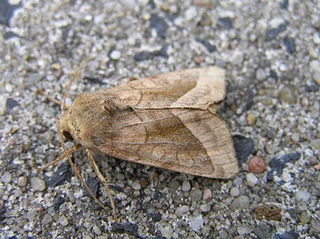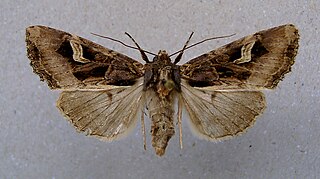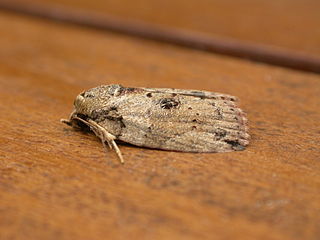
Apamea crenata, known as the clouded-bordered brindle, is a moth in the family Noctuidae. It is distributed throughout the Palearctic realm. In the North it crosses the Arctic Circle, in the Mediterranean it is found only in cool locations and mountains avoiding very hot areas. In the Alps, it rises to an altitude of about 2000 metres.

Miletus symethus, the great brownie, is a small butterfly found in India that belongs to the lycaenids or blues family. The species was first described by Pieter Cramer in 1777.

Nacaduba hermus, the pale four-line blue, is a species of lycaenid butterfly found in Indomalayan realm. The species was first described by Baron Cajetan von Felder in 1860.

Vindula erota, the common cruiser, is a species of nymphalid butterfly found in forested areas of tropical South Asia and Southeast Asia.

Hydraecia micacea, the rosy rustic, is a moth of the family Noctuoidea. It is found across the Palearctic realm from Ireland to Siberia. It reaches Japan and is introduced to eastern USA, Quebec and Ottawa.

Dypterygia scabriuscula, the bird’s wing, is a moth of the family Noctuidae. The species can be found in Europe and the western Palearctic.

Corcobara is a monotypic moth genus of the family Erebidae first described by Frederic Moore in 1882. Its only species, Corcobara angulipennis, described by the same author in the same year, is found in India, Thailand, Cambodia, Myanmar, Malaysia, Indonesia, New Guinea, Sri Lanka and the Solomons.

Mesapamea secalis, the common rustic, is a moth of the family Noctuidae. The species was first described by Carl Linnaeus in his 1758 10th edition of Systema Naturae. It is found in Europe, north-west Africa, Turkey and northern Iran.

Grammodes stolida, the geometrician, is a moth of the family Erebidae. The species was first described by Johan Christian Fabricius in 1775. It is found in Africa, southern Europe, most of Asia and Australia. It migrates to central and northern Europe as far north as England, Denmark and Finland.

The flame brocade is a moth of the family Noctuidae. The nominate subspecies T. f. flammea is found in Europe, mostly in the Mediterranean area up to Normandy. It is also found on the Channel Islands and it has spread to Southern England and Ireland. It is found in the Maghreb as the subspecies T. f. vividior. This also occurs in parts of Spain. The species lives primarily in dry areas, on warm slopes, grassy scrubland and in karstic oak.

Nanaguna breviuscula, the pigeonpea pod borer, is a moth species of the family Nolidae. It is found from Sri Lanka and India east to Samoa. In Australia it is found in the Kimberleys in Western Australia, the northern part of the Northern Territory and from the Torres Strait Islands and Queensland to Sydney in New South Wales.
Phalacra albilinea is a moth in the family Drepanidae. It was described by Warren in 1899. It is found in India.
Epipsestis castaneata is a moth in the family Drepanidae. It was described by Warren in 1915. It is found in Sikkim in India, Hunan in China and in Nepal and Vietnam.
Takapsestis orbicularis is a moth in the family Drepanidae. It is found in India.
Habrona concinna is a moth in the family Drepanidae. It is found in Papua and Papua New Guinea, where it has been recorded from mountainous areas.
Habrona papuata is a moth in the family Drepanidae. It is found in Papua and Papua New Guinea, where it has been recorded from mountainous areas.
Nothoploca nigripunctata is a moth in the family Drepanidae. It is found in India, Vietnam, Korea, China and the Russian Far East.
Striginiana nobilis is a moth in the family Eupterotidae. It was described by William Jacob Holland in 1893. It is found in Gabon.

Chionodes obscurusella, the boxelder leafworm moth, is a moth in the family Gelechiidae. It is found in North America, where it has been recorded from Nova Scotia to Manitoba, south to North Carolina and Oklahoma.
Podalia thanatos is a moth of the Megalopygidae family. It was described by William Schaus in 1905. It is found in Costa Rica and Guyana.











